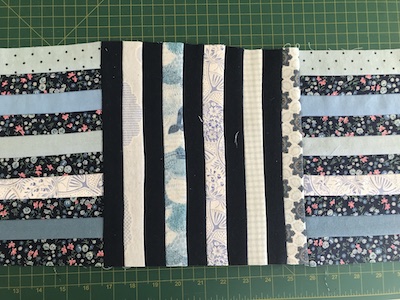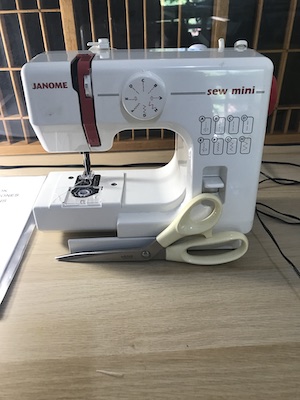I didn’t get back to quilting for a week, and when I did I was all fired up to sew the rows together. However when I looked at them, I realised that in my determination to get the rows sewn, I’d made a big mistake.
My blocks looked wonky.

Some were 9 3/4 inches wide, but most were 9 1/4. I looked at the markings on my square ruler and realised that I’d been distracted by the big fat dominant red lines that marked the half inches, and put my marking tape at the 9 1/4 mark.
Ten stripes together measured 9 3/4 inches. I’d had to do a bit of stretching and pinching of seams to get the blocks to fit together, and this explained why. I went for a walk and considered what to do. I could remove two stripes and cut the blocks down, or I could sew every other seams of the stripes to narrow the strip width. Either way, I was going to have to unpick every row of blocks and rework them in some way.
I decided on the latter option. But I didn’t do all the blocks at once (at first). To make the task seem less like drudgery, I began a quilt-as-you-go method at the same time. (I had been intending to send the quilt to a quilting service, but when I read the tips and tricks on their website it said “Don’t use selvedges” and I groaned aloud. If I’d rejected all the flannelette strips that had selvedges I wouldn’t have had enough for the quilt!)
This meant making a sandwich and quilting the first row, then sewing on the second row and backing at the same time, then tucking batting between and pinning it all together before quilting the new section. Then sewing on the next row until the whole quilt was done.
For the quilting of the first row I did a simple 45 degree angle grid, not trying to be precise. It involved a lot of turning of the fabric sandwich, which I realised was going to get slower and more annoying as the quilt grew in size. So for the second row I did a simpler vertical zig zag, and was able to avoid turning the sandwich by using the backwards stitch on my machine. Having done two different patterns, I decided to see if I could do something different on each additional row. On the third I did wavy horizontal lines, using a walking foot.
As I was fixing the blocks of the fourth row, my machine started breaking needles at random times. It seemed to happen whenever I changed the bobbin, but then it would happen when I hadn’t changed anything – one seam would work perfectly but when I started the next: BAM! Another needle broken. There seemed no option but to take it in for repair.
I’d given my old regular machine to the op shop, so the only back up I had was this:

Which is very cute, very basic, very noisy, but for fixing the blocks it works just fine.
I swear, though, this quilt is cursed.
